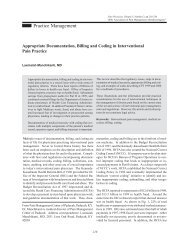ASIPP Practice Guidelines - Pain Physician
ASIPP Practice Guidelines - Pain Physician
ASIPP Practice Guidelines - Pain Physician
Create successful ePaper yourself
Turn your PDF publications into a flip-book with our unique Google optimized e-Paper software.
Manchikanti et al • <strong>ASIPP</strong> <strong>Practice</strong> <strong>Guidelines</strong><br />
64<br />
of respected authorities.<br />
Sympathetic Blocks<br />
Management options for reflex sympathetic dystrophy<br />
(RSD) and causalgia, also known as complex regional pain<br />
syndrome (CRPS) I and II, include sympathetic blocks utilizing<br />
regional anesthetic techniques and radiofrequency<br />
thermoneurolysis or neuromodulation with spinal cord<br />
stimulation or peripheral nerve stimulation.<br />
Radiofrequency neurolysis is an extension of a continuous<br />
regional sympathetic block or neurolytic block providing<br />
long term relief with added safety. Consideration of sympathetic<br />
blocks is to facilitate management of CRPS with<br />
analgesia commensurate with a program of functional restoration<br />
and sympatholysis to provide unequivocal evidence<br />
of sympathetically maintained pain. Once it is established<br />
that sympatholysis is effective in relieving not<br />
only the burning dysesthesia but also allodynia or hyperalgesia,<br />
it is important to repeat the procedure to determine<br />
whether an increasing duration of effect can be expected<br />
in any particular patient. If this is the case, these individual<br />
blocks may be all that are necessary to enable a<br />
patient to regain function. When sympatholysis completely<br />
relieves the symptoms and facilitates exercise therapy but<br />
is limited to its duration of effect, it is appropriate to consider<br />
a prolonged block using radiofrequency neurolysis.<br />
Radiofrequency has been described for lesioning of the<br />
cervical sympathetic chain, thoracic sympathetic chain, and<br />
lumbar sympathetic chain, in cases of CRPS I and II, as<br />
well as for neuropathic pain.<br />
Multiple authors have described their experience with local<br />
anesthetic blockade, as well as radiofrequency neurolysis;<br />
however, there are no large scale either prospective or<br />
retrospective case study series (676-684). However, neurolytic<br />
celiac plexus block for treatment of cancer pain has<br />
received significant attention in the literature (685).<br />
Eisenberg et al (685) performed a meta-analysis of the efficacy<br />
and safety of neurolytic celiac plexus block for cancer<br />
pain. They reviewed a total of 24 papers which met<br />
inclusion criteria with two of them being randomized, controlled<br />
trials (686, 687). One was prospective (688), and<br />
the remaining 21 were uncontrolled, retrospective studies<br />
(685). Both randomized, controlled trials (686, 687)<br />
showed positive results. Eisenberg et al (685) concluded<br />
that short-term success rate of neurolytic celiac plexus block<br />
is approximately 90%, regardless of the underlying type<br />
of cancer. The data analyzed in this review suggested that<br />
neurolytic celiac plexus blocks can at least provide analgesia<br />
in addition to that achieved by opioids, and can reduce<br />
their consumption (685, 689, 690).<br />
There is no significant evidence in the literature in the form<br />
of controlled trials for evaluation and management of sympathetically<br />
maintained pain either with local anesthetic<br />
blocks or neurolytic blocks, including radiofrequency<br />
thermoneurolysis. However, there is moderate evidence for<br />
neurolytic celiac plexus block for the treatment of cancer<br />
pain. Based on this, type and strength of efficacy evidence<br />
is level IV-limited, which is defined as the evidence from<br />
non-experimental studies from more than one center or<br />
research group.<br />
Trigger Point Injections<br />
Trigger point injections are probably the most extensively<br />
used modality of treatment, not only by interventional pain<br />
physicians, but all providers managing pain. Myofascial<br />
pain syndrome is a regional muscle pain disorder accompanied<br />
by trigger points. It has been described as a common<br />
phenomenon in multiple regions, including the spine<br />
(186-189, 202-209). Myofascial trigger points are small,<br />
circumscribed, hyperirritable foci in muscles and fascia,<br />
often found within a firm or taut band of skeletal muscle.<br />
In contrast, nonmyofascial trigger points may also occur<br />
in ligaments, tendons, joint capsule, skin, and periosteum<br />
(202). Trigger points assist in the proper diagnosis of<br />
myofascial pain syndrome, Simons (189) proposed major<br />
and minor criteria that should be met. The clinical criteria<br />
to establish a diagnosis of myofascial pain syndrome include<br />
five major criteria requiring all five to be present:<br />
1. Regional pain complaint,<br />
2. <strong>Pain</strong> complaint or altered sensation in the expected<br />
distribution of referred pain from a trigger point,<br />
3. Taut band palpable in an accessible muscle,<br />
4. Exquisite tenderness at one point along the length<br />
of the taut band, and some degree of restricted<br />
range of motion, when measurable.<br />
Minor criteria of which only one of the three is required<br />
include:<br />
1. Reproduction of clinical pain complaint,<br />
2. Altered sensation, by pressure on the tender spot,<br />
3. Local response elicited by snapping palpation at<br />
the tender spot or by needle insertion into the tender<br />
spot, and<br />
4. <strong>Pain</strong> alleviated by elongating (stretching) the<br />
muscle or by injecting the tender spot.<br />
<strong>Pain</strong> <strong>Physician</strong> Vol. 4, No. 1, 2001
















